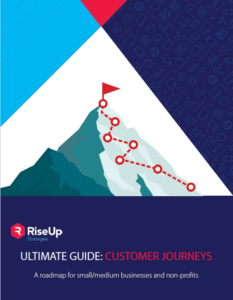These days customers demand a seamless experience from brands. They expect a company to remember their preferences, across multiple devices and experiences and know precisely what they are looking for.
If your company isn’t able to offer this type of experience, customers will often look for another company who will.
One of the most effective ways to ensure that your business is offering a great customer experience that turns first-time visitors into long-term customers is through customer journey mapping.
What is a Customer Journey Map?
A customer journey map is the story of an average individual customer’s experience with your brand. It’s a roadmap of all the interactions current and potential customers have with your business – from awareness all the way (hopefully) to purchase and every step in between.
It can be a very powerful tool for your businesses because it forces you to look at the experience from the perspective of the customer. It helps uncover common customer pain points and friction that is costing your sales and directs enhancements for your business both online and offline.
How to Create a Customer Journey Map?
The concept sounds simple enough, but it can get pretty complex depending on your business model and size. For the purposes of this article we’re going to keep it simple – if you want a more in-depth look at the process, download our free Ebook.
Step 1: Start by sketching out the map – make a note of every time a customer comes in contact with your brand. Make sure to consider things like:
- Ads
- Social media and reviews
- Your website
- Email sign-ups and updates
- The post-purchase process/follow-up
- Your customer service team
* You’ll want to customize this list based on your businesses
Step 2: Now, once you’ve got your map started another layer of information to each touchpoint:
- Customer motivation: What are leads and customers trying to achieve with this touchpoint? (i.e. get information on product quality, browse new products, share feedback, etc.)
- Encouragement: What will encourage your leads/customers (or discourage them) from moving to the next stage of the purchase experience? Consider what kinds of emotions they feel in each one of the stages.
- Barriers: What is stopping customers from moving to the next engagement stage? This could be anything from technical barriers (site is difficult to navigate on mobile) to cost, to uncertainty about quality and many others.
Step 3: Now that you’ve created a map and understand the customer motivations, you can analyze your website and conversion data to prioritize enhancement based on where you’ll get the greatest return on investment.
Investing time into understanding your customer journey and identifying the areas that are creating barriers will help prioritize improvements that help make more positive customer experiences, which will translate to more sales.
Due to the popularity of this process with our existing clients, we’ve created an in-depth guide to help you navigate the customer mapping process. You can get our free Ebook here.
Happy mapping.

Drive customer revenue and loyalty with our Ultimate Guide: Customer Journeys.
Get detailed information about mapping your customer’s experience and identifying opportunities for enhancements.